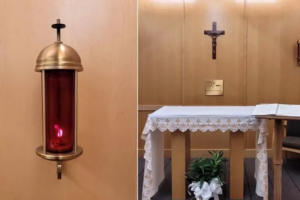CNA—Federal government regulators backed off their demands that a Catholic hospital extinguish its chapel candle after the Oklahoma hospital’s lawyers argued that their client’s religious freedom was being violated.
The hospital was informed that it will receive a waiver, provided it posts signs warning about keeping oxygen equipment away from the tabernacle candle, which is already enclosed and on a wall six feet off the ground. 
The Department of Health and Human Services (HHS) had ordered Saint Francis Health System in Oklahoma to snuff out one of its hospital’s sanctuary candles after one of its contractors responsible for accrediting hospitals deemed that it represented a fire hazard. The hospital group was informed that it would lose its accreditation if it failed to comply; which meant that the hospital group would no longer receive any payment for serving those in need who are on government-dependent healthcare (e.g., Medicare, Medicaid, etc).
HHS reverses course
“The government has seen the light and has abandoned its attempt to force an Oklahoma hospital to blow out a small candle or stop serving elderly, disabled, and low-income patients,” Lori Windham, vice president and senior counsel at the Becket religious liberty legal group, said May 5 on Twitter.
She said the U.S. Department of Health and Human Services has told St. Francis of Assisi “it can keep its living flame — a sacred candle housed in the hospital chapels.”
The hospital is part of Saint Francis Health System, which has five hospitals in eastern Oklahoma. It treats almost 400,000 patients per year and has provided over $650 million in free medical care over the last five years.
The health system’s independent accreditation body, The Joint Commission (TJC), in February cited Saint Francis Hospital South in Tulsa for its chapel tabernacle candle on the grounds it was deficient under fire safety standards. The Centers for Medicare and Medicaid Services (CMS) under the U.S. Department of Health and Human Services then rejected the health system’s multiple appeals to grant a reasonable accommodation.
The threat
The little candle flame had big consequences: If the health system did not comply with the citation, the government could have revoked its ability to serve elderly, disabled, and low-income patients through Medicare, Medicaid, and the Children’s Health Insurance Program, Windham said in a May 2 letter from Becket to CMS.
According to Windham’s letter, the citation was inconsistent with the relevant fire safety rules, the federal Religious Freedom Restoration Act, and the First Amendment of the U.S. Constitution.
“The government knew it was playing with fire — today it announced its decision to allow the living flame so Saint Francis can continue to serve God and its community, as it always has,” Windham said Friday after the government dropped the citation.
In a May 4 letter to Saint Francis Health System, Scott Cooper, director of the Division of Continuing and Acute Care Providers, said that CMS would grant a waiver provided the hospital follows a “plan of correction” to TJC.
This includes what Cooper said were “some simple, appropriate steps to [further] mitigate fire risks.” These include signage to warn patients, visitors and staff about “keeping oxygen equipment and their delivery devices sufficiently far from any flame in the chapel.” This will be the hospital’s “primary action” to mitigate the fire risk.” The hospital, the letter said, should use a rope or other barrier “to serve as a secondary mitigation measure.”
“We recommend continuing to engage with TJC on implementing these solutions and addressing this deficiency citation in a way that mitigates fire risks while still ensuring you can maintain this feature of your chapel.”
A CMS spokesperson told CNA on Friday that “CMS met with the hospital and accreditation organization, and issued a waiver to allow the hospital to mitigate the potential fire risk and correct the safety finding. The hospital will work with the accrediting organization on next steps.”
During a Feb. 21 inspection, Windham’s letter to CMS recounted, a surveyor from The Joint Commission at Saint Francis Hospital South in Tulsa “expressly asked to go to the chapel to see if there was a living flame.” The surveyor observed to hospital personnel that “other Catholic hospitals had complied and extinguished the living flame at their chapels, substituting it with an electric light.”
The surveyor rated the enclosed flame as a “moderate” threat and cited the hospital for violating the CMS Life Safety Code Requirements. While federal standards do classify chapel candles as “flame-producing equipment,” these are only barred within one foot of a nasal cannula, a device to provide supplemental oxygen. The hospital candle is never near such a device. The relevant codes and standards of the National Fire Protection Association expressly permit sanctuary candles.
The reality
The chapel’s candle has never been an issue in previous inspections. Other open flames are permitted at hospitals in kitchen stoves and ovens, gas dryers in the laundry room, flames in gas water heaters, and welding for construction purposes, Windham noted.
According to Windham, the hospital candle is “encased in a thick glass globe, which is itself encased in a second glass globe, covered by a bronze top that fits over the second globe.” This globe rests in a bronze holder affixed to the chapel wall. There are fire extinguishing sprinkler heads around the candle and the local fire marshal has long approved it.
Catholic canon law and liturgical rules require the candles.
The General Instruction on the Roman Missal, approved by the U.S. bishops and the Vatican, says: “In accordance with traditional custom, near the tabernacle a special lamp, fueled by oil or wax, should shine permanently to indicate the presence of Christ and honor it.”
RELATED RESOURCES:
- Feds tell Catholic Hospital to blow out sanctuary light or patients in need lose funding – Catholic Business Journal





You must be logged in to post a comment.